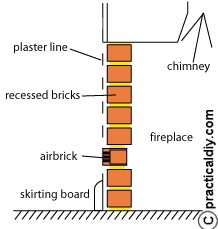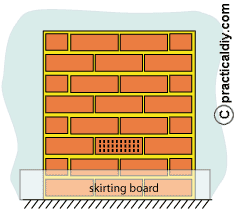Blocking up an unused fireplace
After an old fire surround and hearth has been removed, the hole in the chimney breast can be bricked in to tidy up the wall.
There is no need to remove the fireback from the fireplace, although if a back boiler is fitted, this should be removed once the plumbing has been isolated and disconnected.
Ventilation needs to be provided to the chimney space to avoid moisture collecting on the soot and smoke deposits within the chimney and forming damp areas, this can easily be achieved by building in an air-brick as the fireplace opening is bricked up.
It is also necessary to cap the chimney pot to allow air circulation through the chimney while keeping rain, birds etc out. The easiest way to cap a chimney is to fit an appropriate ventilating cowl to the top of the chimney pot.
Before starting to brick up the fireplace or fitting the ventilation cowl, have the chimney swept one last time to remove as much soot as possible and dislodge any bird nests or other debris. If there is a damper (a small door) where the chimney place enters the chimney, leave this in the open position so as not to restrict the ventilation.
Materials
Common bricks can be used for closing the fireplace, there’s no need to use the more expensive ‘facing’ bricks. Work out how many bricks you require – measure the opening using metric and divide the width by 22cm to give you the number of bricks required for each row, and the height by 7.5cm to give you the numbers of rows – just multiply the two resulting numbers to find the total number of bricks required – then less one for the airbrick.
The mortar needs to be 4:1 sand/cement.
A quantity of plaster will be required to cover the face of the bricks – this can only be applied once the mortar holding the bricks has gone off.
A new section of skirting board will be required to finish off the wall after the plaster has gone off.
A ventilation cowl is required to suit the chimney pot.
Closing the fireplace
Once the chimney has been swept, clear out any debris left on the ‘floor’ of the fireplace.
Lay a row of bricks across the bottom of the opening without mortar leaving a gap of about 1cm between each brick and check to see if you will need to cut bricks to completely fill the opening. If necessary, cut the bricks before you start. Each brick in the second and subsequent rows needs to be centred on the vertical mortar joint in the row below, so again, brick can be cut before you start to achieve this.
Before starting to lay the bricks, dampen the brickwork around the chimney hole – years of having a fire will have well and truly dried out the original brickwork.
 Lay the bottom row of bricks onto a bed of mortar and make sure that mortar is applied between the ends of the bricks and the sides of the opening - set the bricks back from the front edge so that they line up with the original brickwork on each side to leave enough room for the brick to be later plastered to the line of the original plaster. Use a straightedge across the front of the opening onto the original plaster or brickwork to keep the bricks straight.
Lay the bottom row of bricks onto a bed of mortar and make sure that mortar is applied between the ends of the bricks and the sides of the opening - set the bricks back from the front edge so that they line up with the original brickwork on each side to leave enough room for the brick to be later plastered to the line of the original plaster. Use a straightedge across the front of the opening onto the original plaster or brickwork to keep the bricks straight.
Fit the airbrick in the middle of about the third row of new brickwork – the exact position is not important; it need to be fairly low but must not be at the extreme bottom and needs to clear any skirting board being used. The airbrick needs to project forward of the rest of the brickwork so that its front face (with the holes in) is flush with the original plaster on each side – use a straightedge across the front to achieve this.
The top row of bricks will probably be the most awkward to lay – the vertical space will probably not be a full brick high; one option is to fill the gap using broken roof tiles embedded in the mortar, start at the sides applying mortar into the gap and slide the pieces of tile into the mortar sideways – pushing the pieces in from the front will tend to push the mortar out the back, pushing them in sideways will tend to push the mortar between the brick below and the chimney breast lintel above.
 When the brickwork is complete, “rake” out the mortar joints to give a good key for the plastering to follow.
When the brickwork is complete, “rake” out the mortar joints to give a good key for the plastering to follow.
After the mortar has gone off and the brickwork is firm, carry out the plastering as detailed in our articles for ‘repairing plaster on masonry walls’ – don’t be in too much of a hurry to start plastering, if you start too soon the brickwork may not be firm enough and you could push over the wall you've built to close up the fireplace. Take care when plastering to avoid covering the holes in the airbrick.
After the plastering has been completed, you can fix a new piece of skirting across the bottom of the chimney breast – rather than just fitting a new piece across where the hearth was, it usually give a better finish if the short lengths of original skirting either side of the hearth are removed back to the corner and a new piece fitted across the complete front of the chimney breast.
The final job is to fit the ventilation cowl to the chimney pot - this is probably the worst part of the job especially if you don’t like heights. Do not take any chances when working on the roof, it may appear to be only a ‘five minute job’ but you need to gain safe access to the chimney stack and then reach the top of the chimney pot. Your may feel better if you let a professional roofer do the job even if you have to pay him. Whatever you do, work safe and don’t take chances.
